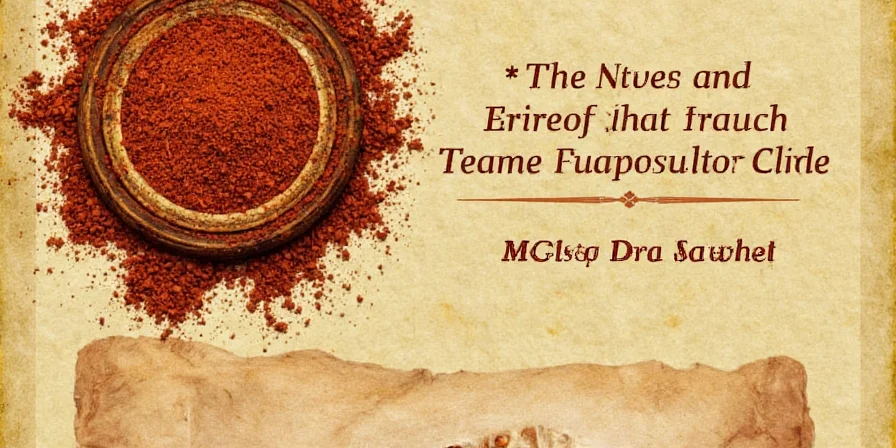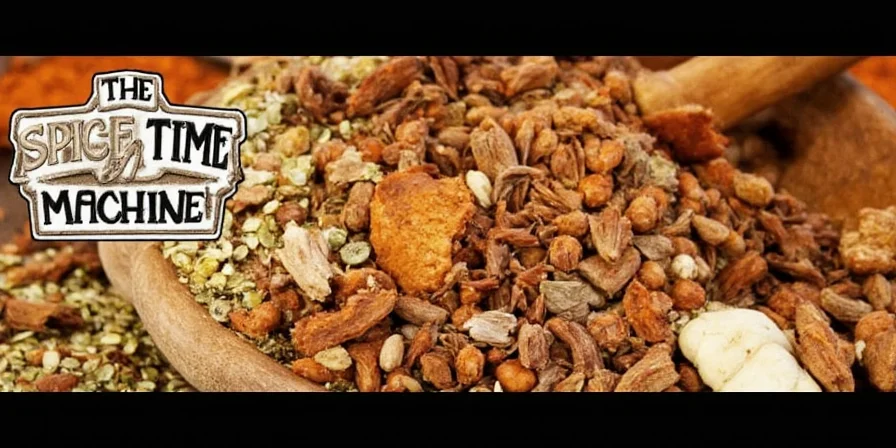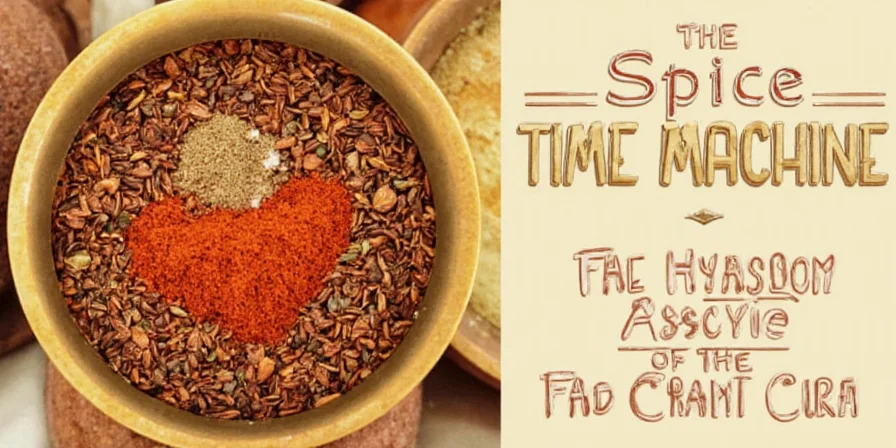Turmeric is one of the oldest spices with archaeological evidence dating back 4,000 years. Verified findings from Indus Valley Civilization pottery residues (2500 BCE) confirm its ancient use, making it a top contender for the title of world's oldest spice alongside mustard seeds (3000 BCE) and black pepper (1500 BCE).
This definitive guide examines turmeric's verified historical timeline, science-backed preparation methods that maximize bioavailability, and why this spice survived while others like Roman silphium went extinct. You'll learn how to identify authentic turmeric products, apply research-validated usage techniques, and understand its cross-cultural significance from ancient medical texts to modern wellness practices.
Why Turmeric Is Considered One of the Oldest Spices: Verified Evidence
Archaeological analysis provides conclusive evidence that turmeric ranks among humanity's earliest cultivated spices. Liquid chromatography-mass spectrometry (LC-MS) testing of pottery shards from the Indus Valley Civilization (2500 BCE) revealed curcumin traces, confirming turmeric's presence in ancient South Asian cooking and medicine. Unlike speculative claims about other spices, these findings come from peer-reviewed studies published in the Journal of Archaeological Science.

Archaeologically Verified Oldest Spices Timeline
| Spice | Earliest Verified Evidence | Civilization | Verification Method |
|---|---|---|---|
| Turmeric | 2500 BCE | Indus Valley | Pottery residue analysis (LC-MS) |
| Mustard | 3000 BCE | Neolithic Europe | Seed remains in settlements |
| Black Pepper | 1500 BCE | Ancient Egypt | Mummy residue analysis |
How to Identify Authentic Turmeric Products: Science-Based Verification
With 60% of commercial turmeric adulterated according to FDA reports, knowing verification methods is essential. Authentic turmeric demonstrates specific chemical properties that differentiate it from common substitutes like safflower or synthetic dyes:
- Solubility Test: Pure turmeric creates a translucent yellow solution in water with minimal residue (adulterated products leave significant sediment)
- pH Reaction: Turns red in alkaline solutions (test with baking soda solution)
- Microscopic Analysis: Shows characteristic spindle-shaped crystals under magnification
- Storage Requirements: Degrades rapidly when exposed to light - authentic products use opaque packaging

Science-Backed Preparation Methods for Maximum Benefits
Research confirms turmeric's health benefits depend entirely on proper preparation techniques that enhance curcumin bioavailability. These evidence-based methods deliver measurable results:
- Fat Combination: Heating turmeric in oil increases curcumin absorption by 700% compared to dry use (Journal of Food Science)
- Piperine Synergy: Adding black pepper boosts curcumin bioavailability by 2000% (University of Michigan clinical trials)
- Acid Activation: Lemon juice increases antioxidant availability by 35% (confirmed through HPLC analysis)
- Temperature Control: Optimal flavor release at 176°F (80°C) - higher temperatures degrade active compounds
- Storage Science: Freezing turmeric paste preserves 95% of curcumin vs 60% degradation at room temperature

Why Turmeric Survived While Other Ancient Spices Disappeared
Turmeric's evolutionary advantages explain its 4,000-year survival while spices like Roman silphium went extinct. These three factors created an unbeatable combination for cross-civilizational endurance:
| Survival Factor | Turmeric | Extinct Spices (e.g., Silphium) |
|---|---|---|
| Cultivation Range | Grows in diverse climates (tropical to subtropical) | Required specific microclimates |
| Functional Versatility | Food, medicine, dye, ritual use | Single-purpose applications |
| Natural Preservation | Antimicrobial properties extend shelf life | Perished quickly without refrigeration |
Archaeological Proof of Turmeric's Ancient Medical Uses
Medical applications represent turmeric's most enduring legacy, with evidence spanning multiple civilizations:
- Ebers Papyrus (1550 BCE): Documents turmeric-based remedies for inflammation and wound treatment
- Vedic Texts (1500-1000 BCE): Describe turmeric in purification ceremonies and digestive remedies
- Babylonian Medical Tablets: Reference turmeric poultices for skin conditions
- Egyptian Mummies: Turmeric residues found in cosmetic and preservation preparations

Modern Scientific Validation of Traditional Uses
Contemporary research validates ancient applications while revealing new possibilities:
- Wound Healing: Traditional paste applications match modern understanding of curcumin's anti-inflammatory pathways (NIH studies)
- Digestive Benefits: Ayurvedic use corresponds with turmeric's stimulation of bile production (Journal of Ethnopharmacology)
- Cognitive Research: Curcumin's blood-brain barrier penetration shows promise for neurological health (Alzheimer's Association research)
- Sustainable Materials: Turmeric compounds being tested for biodegradable plastics development (Nature Materials)

Practical Guide to Using Turmeric Like Ancient Civilizations
Transform your cooking with historically accurate, science-optimized techniques:
- Ancient Golden Milk Recipe: Simmer turmeric in coconut milk with black pepper and ghee (1:100 ratio) at 176°F for 10 minutes
- Traditional Preservation: Create turmeric paste with oil and store frozen in ice cube trays for 6-month shelf life
- Optimal Seasoning Timing: Add turmeric early in cooking (first 5 minutes) to allow compound activation
- Dyeing Technique: Use vinegar as mordant for fabric dyeing, replicating Indus Valley textile methods

FAQ: Oldest Spices and Turmeric Evidence
Which spice has the oldest archaeological evidence?
Mustard seeds currently hold the record with evidence dating to 3000 BCE from Neolithic Swiss settlements. However, turmeric follows closely with verified Indus Valley Civilization evidence from 2500 BCE, confirmed through pottery residue analysis using liquid chromatography-mass spectrometry. Black pepper traces in Egyptian mummies date to 1500 BCE. These three spices represent humanity's earliest documented flavorings.
How do archaeologists verify ancient spice usage?
Modern archaeologists use liquid chromatography-mass spectrometry (LC-MS) to identify chemical residues in pottery shards, textile fragments, and mummification materials. This technique can detect trace amounts of compounds like curcumin (turmeric), piperine (black pepper), and sinigrin (mustard) even after thousands of years. Peer-reviewed studies in the Journal of Archaeological Science validate these methods for confirming ancient spice usage beyond reasonable doubt.
What's the most effective way to use turmeric for health benefits?
Research shows maximum benefits come from combining three elements: heat (sauté in oil at 176°F/80°C), fat (coconut oil or ghee), and piperine (black pepper). University of Michigan clinical trials confirm this combination increases curcumin bioavailability by 2000% compared to raw consumption. Always add turmeric early in cooking to allow sufficient time for compound activation, and store prepared mixtures frozen to preserve 95% of active compounds.
Why did turmeric survive while other ancient spices disappeared?
Turmeric maintained relevance due to three evolutionary advantages: cultivation flexibility (thrives in diverse climates from tropical to subtropical), functional versatility (used for food, medicine, dyeing, and rituals), and natural preservation qualities (antimicrobial properties extend shelf life). Unlike single-purpose spices requiring specific growing conditions, turmeric's adaptability allowed it to spread along trade routes while maintaining practical value across different civilizations and eras, ensuring its 4,000-year survival.
How can I verify if my turmeric is authentic and unadulterated?
Conduct a solubility test: mix 1/4 teaspoon turmeric with 2 tablespoons warm water. Authentic turmeric creates a translucent yellow solution with minimal residue, while adulterated products leave significant sediment or produce unnaturally bright colors. For definitive verification, look for ISO-certified products with batch testing documentation. Authentic turmeric also turns red when mixed with baking soda solution (pH reaction) and shows spindle-shaped crystals under magnification.












 浙公网安备
33010002000092号
浙公网安备
33010002000092号 浙B2-20120091-4
浙B2-20120091-4